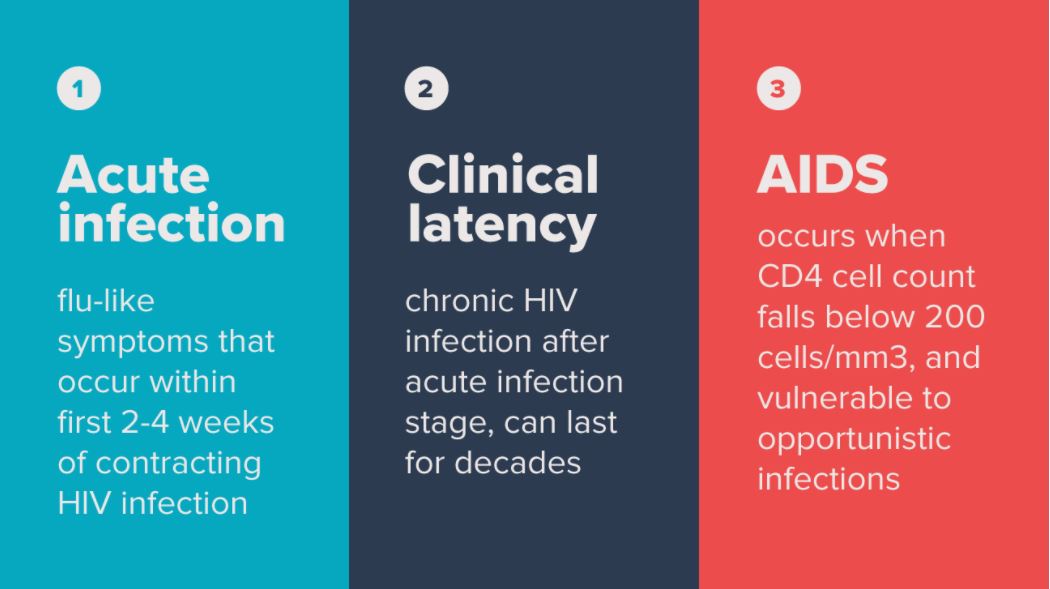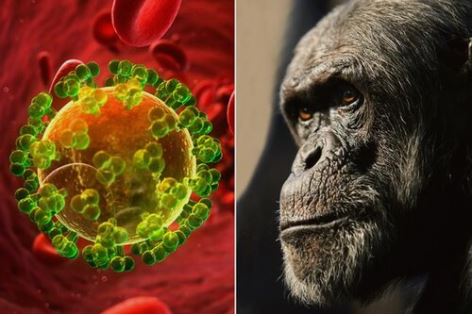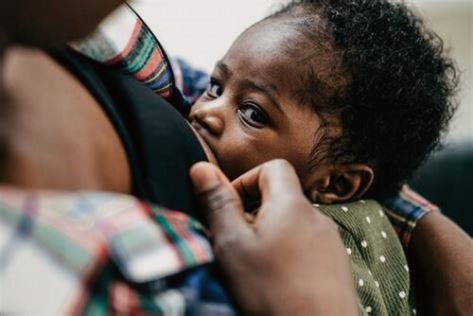HIV Basics
What is HIV?
HIV/AIDS
Also called: human immunodeficiency virus, acquired immunodeficiency syndrome
HIV causes AIDS and interferes with the body’s ability to fight infections.
The virus can be transmitted through contact with infected blood, semen, or vaginal fluids.
Within a few weeks of HIV infection, flu-like symptoms such as fever, sore throat, and fatigue can occur. Then the disease is usually asymptomatic until it progresses to AIDS. AIDS symptoms include weight loss, fever or night sweats, fatigue, and recurrent infections.
No cure exists for AIDS, but strict adherence to anti-retroviral therapy (ART) can dramatically slow the disease’s progress, prevent secondary infections and complications, and prolong life.
What you should know

What are the stages of HIV?
Stage 1 Acute HIV Infection
- People have a large amount of HIV in their blood . They are very contagious.
- Some people have flu-like symptoms. This is the body’s natural response to infection.
- But some people may not feel sick right away or at all.
- If you have flu-like symptoms and think you may have been exposed to HIV, seek medical care and ask for a test to diagnose acute infection.
- Only antigen/antibody tests or nucleic acid tests (NATs) can diagnose acute infection.
Stage 2 Chronic HIV Infection
-
This stage is also called asymptomatic HIV infection or clinical latency
-
HIV is still active but reproduces at very low levels.
-
People may not have any symptoms or get sick during this phase
-
Without taking HIV medicine, this period may last a decade or longer, but some may progress faster
-
People can transmit HIV in the phase
-
At the end of this phase, the amount of HIV in the blood (called viral load) goes up and the CD4 cell count goes down. The person may have symptoms as the virus levels increase in the body, and the person moves into Stage 3.
-
People who take HIV medicine as prescribed may never move into Stage 3
Stage 3 Acquired Immunodeficiency Syndrome (AIDS)
-
The most severe phase of HIV infection
-
People with AIDS have such badly damaged immune systems that they get an increasing number of severe illnesses, called opportunistic infections
-
People receive an AIDS diagnosis when their CD4 cell count drops below 200 cells/mm, or if they develop certain opportunistic infections
-
People with AIDS can have high viral load and be very infectious
-
Without treatment, people with AIDS typically survive about three years

Where did HIV come from?
HIV infection in human came from a type of chimpanzee in nCentral Africa.
The chimpanzee version of the virus (called simian immunodeficiency virus, or SIV) was probably passed to humans when humans hunted hunted these chimpanzees for meat and came in contact with their infected blood.
Studies show that HIV may have jumped from chimpanzees to humans as far back as the late 1800s.
Over decades, HIV slowly spread across Africa and later into other parts of the world. We know the virus has existed in the United States since at least the mid to late 1970s.
How is HIV passed from one person to another?
Most people who get HIV get it through anal or caginal sex, or sharing needles, syringes, or other drug injection equipment. But there are powerful tools that can help prevent HIV transmission.

Can I get HIV from anal sex?
You can get HIV if you have anal sex with someone who has HIV without using protection (like condoms or medicine to treat or prevent HIV)
-
Anal sex is the riskiest type of sex for getting or transmitting HIV
-
Being the receptive partner (bottom) is riskier for getting HIV than being the insertive partner (top)
-
The bottom’s risk of getting HIV is very high because the rectum’s lining is this and may allow HIV to enter the body during anal sex.
-
The top is also at risk because HIV can enter the body through the opening at the tip of the penis (or urethra), the foreskin if the penis isn’t circumcised, or small cuts, scratches, or open sores anywhere on the penis
Can I get HIV from vaginal sex?
You can get HIV if you vaginal sex with someone who has HIV without using protection (like condoms or medicine to treat or prevent HIV)
-
Vaginal sex is less risky for getting HIV than receptive anal sex
-
Either partner can get HIV during vaginal sex
-
Most women who get HIV get it from vaginal sex. HIV can enter a women’s body during vaginal sex through the mucous membranes that line the vagina and cervix
-
Men can also get HIV during vaginal sex. This is because vaginal fluid and blood can carry HIV. Men get HIV through the opening at the tip of the penis (or urethra), the foreskin if the penis isn’t circumcised, or small cuts, scratches, or open sores anywhere on the penis.

Can HIV be transmitted from a mother to her baby?
HIV can be transmitted from a mother to her baby during pregnancy, birth, or breastfeeding. However, it is less common because of advances in HIV prevention and treatment.
-
This is called perinatal transmission or mother to child transmission
-
Mother to child transmission is the most common way that children get HIV
-
Recommendations to test all pregnant women for HIV and start HIV treatment immediately have lowered the number of babies who are born with HIV
-
If a mother with HIV takes HIV medicine daily as prescribed throughout pregnancy and childbirth, and gives HIV medicine to her baby for 4 to 6 weeks after giving birth, the risk of transmitting HIV to the baby can be less than 1%.
Can I get HIV from sharing needles, syringes, or other drug injection equipment?
You are at high risk for getting HIV if you share needles, syringes, or other drug injection equipment (for example), cookers) with someone with has HIV. Never share needles or other equipment to inject drugs, hormones, steroids, or silicone.
-
Used needles, syringes, and other injection equipment may have someone else’s blood on them, and blood can carry HIV
-
People who inject drugs are also at risk for getting HIV (and other sexually transmitted diseases) because they may engage in risky sexual behavior s like having sex without protection (such as condoms or medicine to prevent or treat hIV)
-
You’re als at risk for getting hepatitis B and C, and other infections if you share needles, syringes, or other injection equipment.
What are some rare ways that HIV has been transmitted?
There is little to no risk of getting HIV from the activities below. For transmission to occur, something very unusual would have to happen.
Oral Sex
Workplace
Medical Care
Pre-Chewed Food
Biting
Deep, Open- Mouth Kissing
Female to Female
Tattoos and Body Piercings
